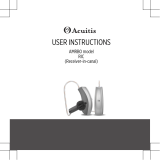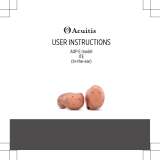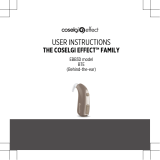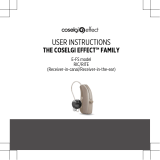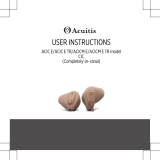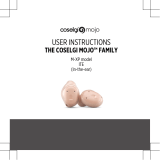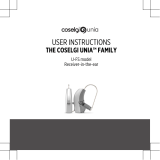Page is loading ...

USER INSTRUCTIONS
THE WIDEX EVOKE™ FAMILY
E-FS model
RIC/RITE
(Receiver-in-canal/Receiver-in-the-ear)

YOUR HEARING AID
(To be filled out by the hearing care professional)
Your hearing aid series:
Zinc-air battery (steel coloured) Silver-zinc battery (golden)
PROGRAMS
Universal Audibility Extender
Quiet Audibility Extender
Comfort Audibility Extender
Transport Audibility Extender
Urban Audibility Extender
Impact Audibility Extender
Party Audibility Extender
Social Audibility Extender
Music Audibility Extender
T Audibility Extender
M+T Audibility Extender
2

SPECIAL PROGRAMS
Zen Audibility Extender
Phone Audibility Extender
SMARTTOGGLE PROGRAMS
Zen+ Audibility Extender
Phone+ Audibility Extender
NOTE
The program names in the table are the default names. If you have chosen to
use some of the other names available, write the new names in the table. That
way you will always know which programs you have in your hearing aids.
NOTE
Read this booklet and the booklet "Ear-sets for Widex hearing aids" carefully
before you start using your hearing aid.
NOTE
This hearing aid allows direct wireless control and sound streaming from
smartphones and other devices. For more help and information contact your
hearing care professional or visit: global.widex.com/EVOKE.
This hearing aid works wirelessly with the TONELINK App. We take no
responsibility if the hearing aid is used with any third part App or if the
TONELINK App is used with any other device.
3

CONTENTS
YOUR HEARING AID...................................................................................6
Welcome...........................................................................................................6
Your hearing aid at a glance.......................................................................6
FS model with silver-zinc rechargeable batteries....................................7
The charger...................................................................................................7
Important safety information.........................................................................8
THE HEARING AID.................................................................................... 10
Indications for use..........................................................................................10
Hearing aids with rechargeable batteries............................................... 10
Intended use...................................................................................................10
The zinc-air battery........................................................................................10
Low battery indication................................................................................11
Changing the battery.................................................................................. 11
Tamper-resistant battery drawer.............................................................13
The silver zinc battery....................................................................................13
Inserting a rechargeable battery.............................................................. 14
Recharging your hearing aids...................................................................16
Sound signals..................................................................................................17
Lost partner ................................................................................................ 17
How to tell right from left..............................................................................17
4

Turning the hearing aid on and off...............................................................17
Putting on and removing the hearing aid...................................................18
Programs.........................................................................................................19
The Zen program........................................................................................22
Program and sound adjustment..................................................................22
Using a phone with your hearing aids........................................................ 23
PAIRING YOUR HEARING AID AND SMARTPHONE...................................24
CLEANING................................................................................................25
Tools................................................................................................................25
Cleaning..........................................................................................................25
ACCESSORIES.......................................................................................... 27
TROUBLESHOOTING................................................................................ 28
CERTIFIED POWER ADAPTERS FOR RECHARGEABLE SOLUTIONS............31
REGULATORY INFORMATION...................................................................32
EU directives...................................................................................................32
Directive 2014/53/EU................................................................................ 32
Information regarding disposal................................................................32
FCC and ISED statements.............................................................................33
SYMBOLS.................................................................................................36
5

YOUR HEARING AID
Welcome
Congratulations on your new hearing aid.
Use your hearing aid regularly, even if it takes some time getting used to it.
Infrequent users don’t usually get the full benefit of a hearing aid.
NOTE
Your hearing aid and its accessories may not look exactly as illustrated in this
booklet. We also reserve the right to make any changes we consider necessary.
Your hearing aid at a glance
The illustration shows your hearing aid without the ear-set. For further
information on the ear-set see the ear-set manual. The ear-set consists of an
earwire and an ear-tip, and it is the part of your hearing aid that you wear
inside your ear.
3
1/2
4
1. On/off switch
2. Battery drawer with nail grip
3. Program button
4. Left/right identification. Blue indicates
your left hearing aid, while red is for
your right hearing aid.
6

FS model with silver-zinc rechargeable batteries
1
2
3
1. Push button
2. Battery compartment
3. Earwire
The charger
1
2
1. Charging slot
2. LED
USB cable (to be connected to a certified power
adapter. See the "Certified power adapters for
rechargeable solutions" section).
NOTE
You should only use your charger indoors.
NOTE
Never leave the charger in direct sunlight and do not immerse it in water.
7

Important safety information
Read these pages carefully before you begin using your hearing aid.
Hearing aids and batteries can be dangerous if swallowed or used
improperly. Swallowing or improper use can result in severe injury or
even fatalities. In case of ingestion, contact your local emergency
number or hospital immediately.
Take your hearing aids out when you are not using them. This will help to
ventilate the ear canal and prevent ear infections.
Contact your doctor or hearing care professional immediately if you
suspect you may have an ear infection.
Remove your hearing aids before showering, swimming or using a hair
dryer.
Do not wear your hearing aids when applying perfume, spray, gels, lotion
or cream.
Do not dry your hearing aid in a microwave oven - this will ruin it.
Never use other people’s hearing aids and never allow others to use
yours, as this could damage your hearing.
Never use your hearing aids in environments where there may be
explosive gases, such as in mines, etc.
Keep hearing aids, their parts, accessories and batteries away from
children and mentally disabled people.
8

Never try to open or repair the hearing aid yourself. Contact your hearing
care professional if you need to have your hearing aid repaired.
Your hearing aids contain radio communication technology. Always
observe the environment in which you are using them. If any restrictions
apply, you must take precautions to comply with these.
Your hearing aid is very powerful and it can play sounds that exceed a
level of 132 dB. There may therefore be a risk of damaging your
remaining hearing.
Do not expose your hearing aids to extreme temperatures or high
humidity, and dry them quickly if they get wet, or if you perspire heavily.
Please note that streaming sound to your hearing aids at a high volume
can prevent you from hearing other important sounds such as alarms and
traffic noise. In such situations make sure to keep the volume of the
streamed sound at a suitable level.
Your hearing aids should be stored and transported within the temperature
and humidity ranges of -20°C to +55°C (-4°F to 131°F) and 10%-95% rH.
Your hearing aids are designed to operate within the temperature, humidity
and atmospheric pressure ranges of 0°C (32°F) to 50°C (122°F), 10%-95% rH
and 750 to 1060 mBar.
You can find technical data sheets and additional information on your
hearing aids on https://global.widex.com.
9

THE HEARING AID
Indications for use
The hearing aids are indicated for individuals older than 36 months with a
range of hearing loss from minimal (10 dB HL) to severe-to-profound (100
dB HL) and all hearing loss configurations.
They are to be programmed by licensed hearing care professionals
(audiologists, hearing aid specialists, otolaryngologists) who are trained in
hearing (re)habilitation.
Hearing aids with rechargeable batteries
Hearing aids with rechargeable batteries should NOT be used by children
younger than 36 months or mentally disabled people.
Intended use
The hearing aids are intended as air conduction amplification devices to be
used in everyday listening environments. The hearing aids may be equipped
with the Zen program, intended to provide a relaxing sound background
(i.e. music/noise source) for adults who desire to listen to such a
background in the quiet.
The zinc-air battery
Use a type 312 zinc-air battery for your hearing aid.
Always use a fresh, new battery that is precisely the kind recommended by
your hearing care professional.
10

NOTE
Check that the battery is completely clean and free of any residue before
inserting it in the hearing aid. Otherwise your hearing aid may not function as
expected.
Never attempt to recharge a zinc-air hearing aid battery, as it could
explode.
Never leave a flat battery in the hearing aids while storing them. It could
leak and ruin your hearing aid.
Dispose of used batteries as indicated on the packaging and take note of
the expiry date.
Low battery indication
When the battery is flat, a sound signal will play. If the battery drains
suddenly there may however be no warning. We recommend carrying a
spare battery with you wherever you go.
Changing the battery
To change the battery, do as follows:
Take the adhesive tab off the new battery and make
sure there is no sticky substance left on it. Let it
"breathe" for 60 seconds.
Use the nail grip to gently swing the battery door
open and remove the old battery.
11

Now place the new battery in the drawer as shown.
Close the drawer. If it doesn't close easily, the
battery is not placed correctly.
If you are not using the hearing aid for a few days,
remove the battery.
NOTE
Avoid dropping your hearing aid - hold the hearing aid above a soft surface
while changing the battery.
WARNING - KEEP BATTERIES OUT OF REACH OF CHILDREN
●For some types of button batteries, swallowing may lead to serious
injury in as little as two hours or death, due to chemical burns and the
potential perforation of the oesophagus.
●If you suspect your child has swallowed or inserted a button battery, call
the 24-hour Poisons Information Centre immediately on 13 11 26 for fast,
expert advice.
●Examine devices and make sure the battery compartment is correctly
secured, e.g. that the screw or other mechanical fastener is tightened.
Do not use if compartment is not secure.
●Dispose of used button batteries immediately and safely. Used/
discharged batteries can still be dangerous.
●Tell others about the risk associated with button batteries and how to
keep their children safe.
12

Tamper-resistant battery drawer
If the hearing aid is going to be used by a child or a mentally disabled
person, you can ask your hearing care professional to provide it with a
tamper-resistant battery drawer.
To open battery drawer, use the special tool you've
received, and do as illustrated.
NOTE
This option is not available if your hearing aids use silver-zinc rechargeable
batteries.
The silver zinc battery
Use a type 312 silver-zinc battery for your hearing aid.
Always use a new battery supplied by your hearing care professional.
Dispose of used batteries as indicated on the packaging and take note of
the expiry date.
NOTE
Recharge the batteries before using your hearing aids.
13

NOTE
If you are not going to use your hearing aid for several days, remove the
batteries.
NOTE
Your rechargeable batteries should last for approximately one year. Ask your
hearing care professional to change them for you when needed.
Inserting a rechargeable battery
To insert a new rechargeable battery do as follows:
Open the battery compartment.
Now place the battery in the battery compartment
with the golden side facing upwards and close the
battery compartment.
NOTE
You can also use a zinc-air battery with your hearing aid.
NOTE
Avoid dropping your hearing aid - hold the hearing aid above a soft surface
while changing the battery.
14

NOTE
You can also ask your hearing care professional for help if you need to change
the rechargeable battery.
WARNING - KEEP BATTERIES OUT OF REACH OF CHILDREN
●For some types of button batteries, swallowing may lead to serious
injury in as little as two hours or death, due to chemical burns and the
potential perforation of the oesophagus.
●If you suspect your child has swallowed or inserted a button battery, call
the 24-hour Poisons Information Centre immediately on 13 11 26 for fast,
expert advice.
●Examine devices and make sure the battery compartment is correctly
secured, e.g. that the screw or other mechanical fastener is tightened.
Do not use if compartment is not secure.
●Dispose of used button batteries immediately and safely. Used/
discharged batteries can still be dangerous.
●Tell others about the risk associated with button batteries and how to
keep their children safe.
15

Recharging your hearing aids
Connect the USB cable into the charger and plug it
into the wall socket.
Hold your hearing aid by the earwire and gently
place it on the charging slot.
The green light will start blinking as soon as your
hearing aids start charging.
Once the hearing aids are completely charged, the
green light will stop blinking and it will be solid
green.
NOTE
Always charge the silver-zinc batteries at temperatures between 10°C (50°F)
and 40°C (104°F).
NOTE
Don't leave the hearing aids on the charger once the batteries have been
recharged, unless you keep the charger connected to the power supply -
otherwise the batteries will be drained.
16

Sound signals
Your hearing aid plays sounds to inform you that certain features have been
activated or that you have changed program. These sounds can be spoken
messages or tones.
Ask your hearing care professional to turn these sounds off if you don't need
them.
Lost partner
(Only available in selected models)
Your hearing care professional can turn on a feature in your hearing aid that
warns you whenever it loses contact with the hearing aid in the opposite
ear. You will hear a spoken message in your ear.
How to tell right from left
The hearing aid for your right ear has a red mark. The hearing aid for your
left ear has a blue mark.
Turning the hearing aid on and off
To turn the hearing aid on, close the battery door. The
hearing aid will play a sound signal to indicate that it is
on, unless your hearing care professional has
deactivated this function.
17

To turn off the hearing aid, pull the battery door
downwards.
NOTE
Don't forget to turn off the hearing aid when it is not in use.
Putting on and removing the hearing aid
Putting on the hearing aid
1
2
1. Insert the ear-set in the ear while holding the lower
part of the tube/earwire. Pulling the outer ear upwards
and backwards at the same time can be helpful.
2. Then place the hearing aid behind the ear. The hearing
aid should rest comfortably on the ear, close to your
head.
Your hearing aid can be fitted using different types of ear-sets. See the
separate ear-set manual for more information about your ear-set.
18

Removing the hearing aid
Start by removing the hearing aid from behind the
ear.
Then take the ear-set carefully out of the ear canal
while you hold the lower part of the tube/earwire.
Programs
PROGRAMS USE
Universal For everyday use
Quiet Special program for listening in quiet
environments
Comfort Special program for listening in noisy
environments
Transport For listening in situations with noise from cars,
trains, etc.
Impact Use this program if you prefer a clear and sharp
sound
Urban For listening in situations with changing sound
levels (in supermarkets, noisy workplaces or
similar)
19

PROGRAMS USE
Party For listening in situations with many people
talking at the same time
Social Use this program if you are in small social
gatherings, such as family dinners
Music For listening to music
T With this program you listen through the
hearing aid's telecoil, which allows you to listen
directly to the sound without background noise
(requires a teleloop system)
M+T This program is a combination of the hearing
aid's microphone and the telecoil. You listen to
the sound source, but can also hear other sounds
SPECIAL PROGRAMS USE
Zen Plays tones or noise for a relaxing sound
background
Phone This program is designed for listening to phone
conversations
20
/
